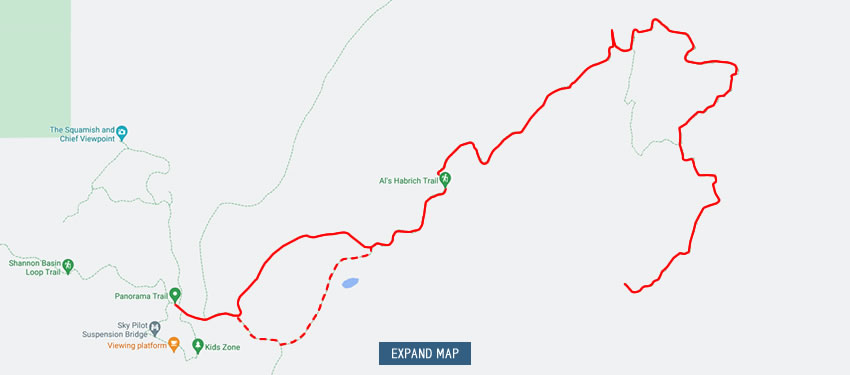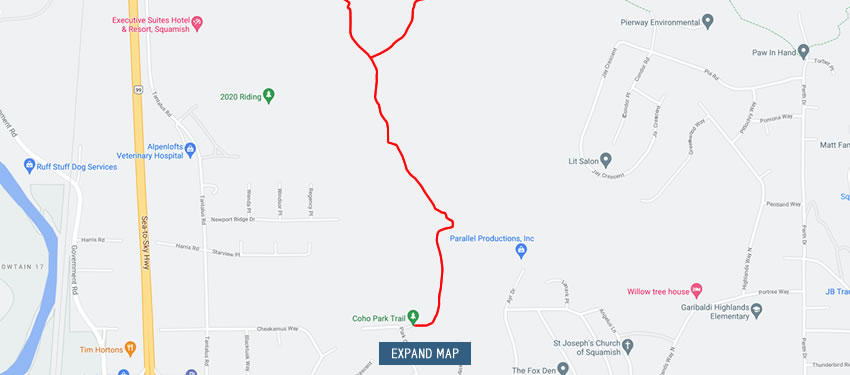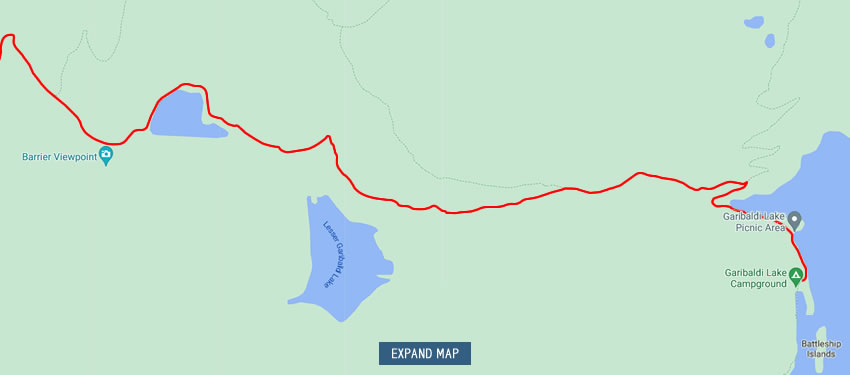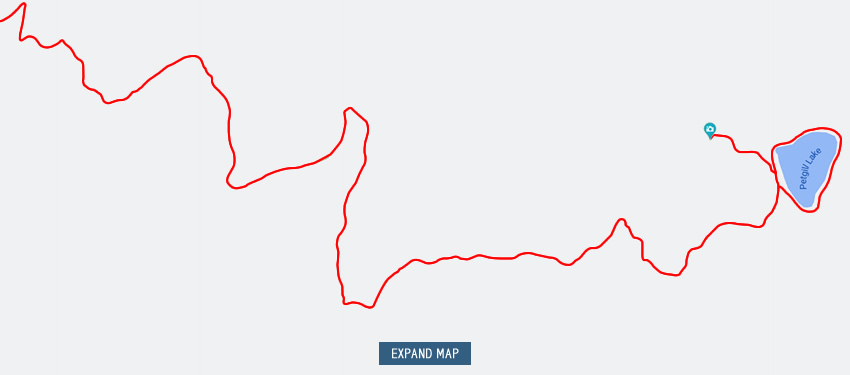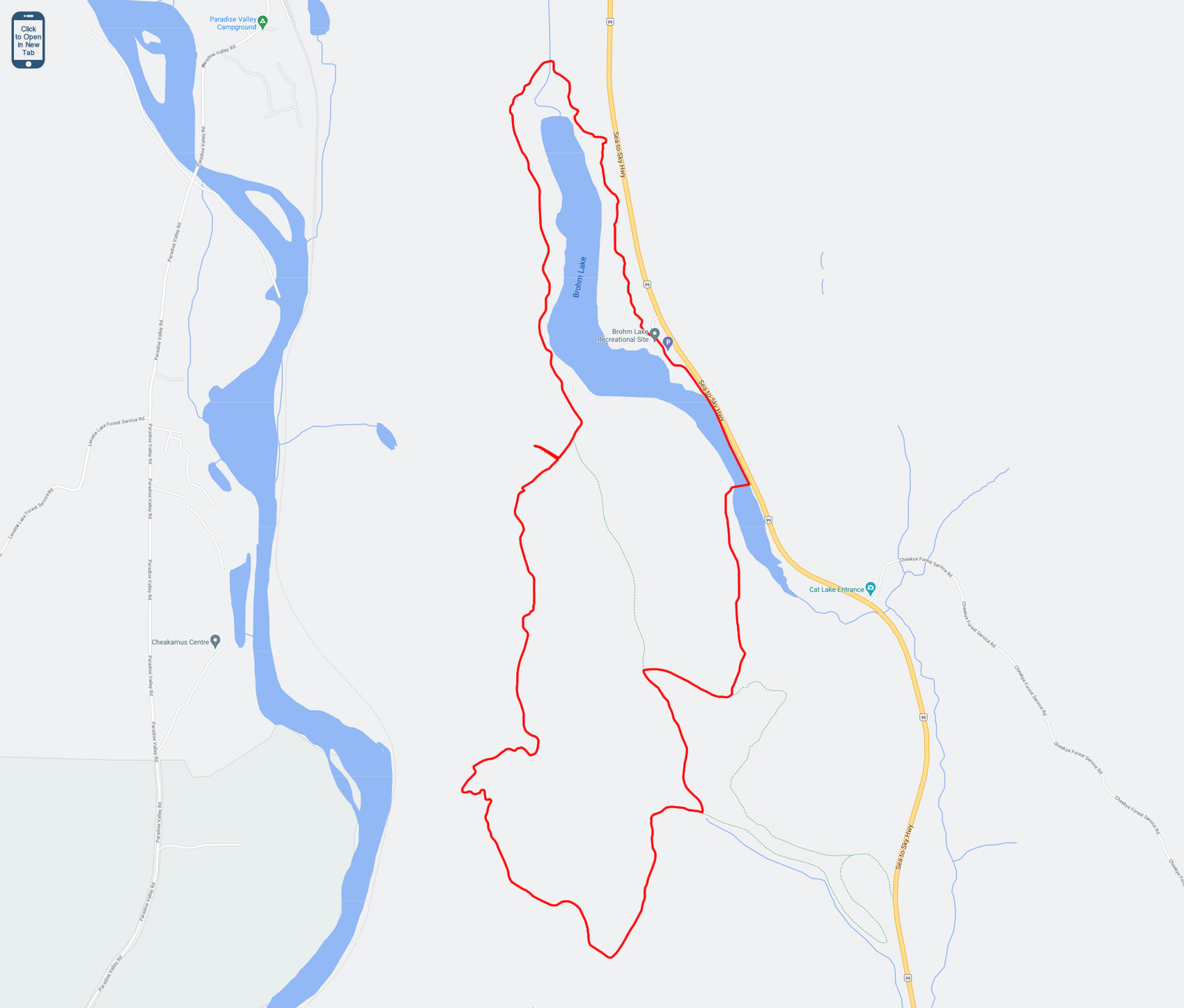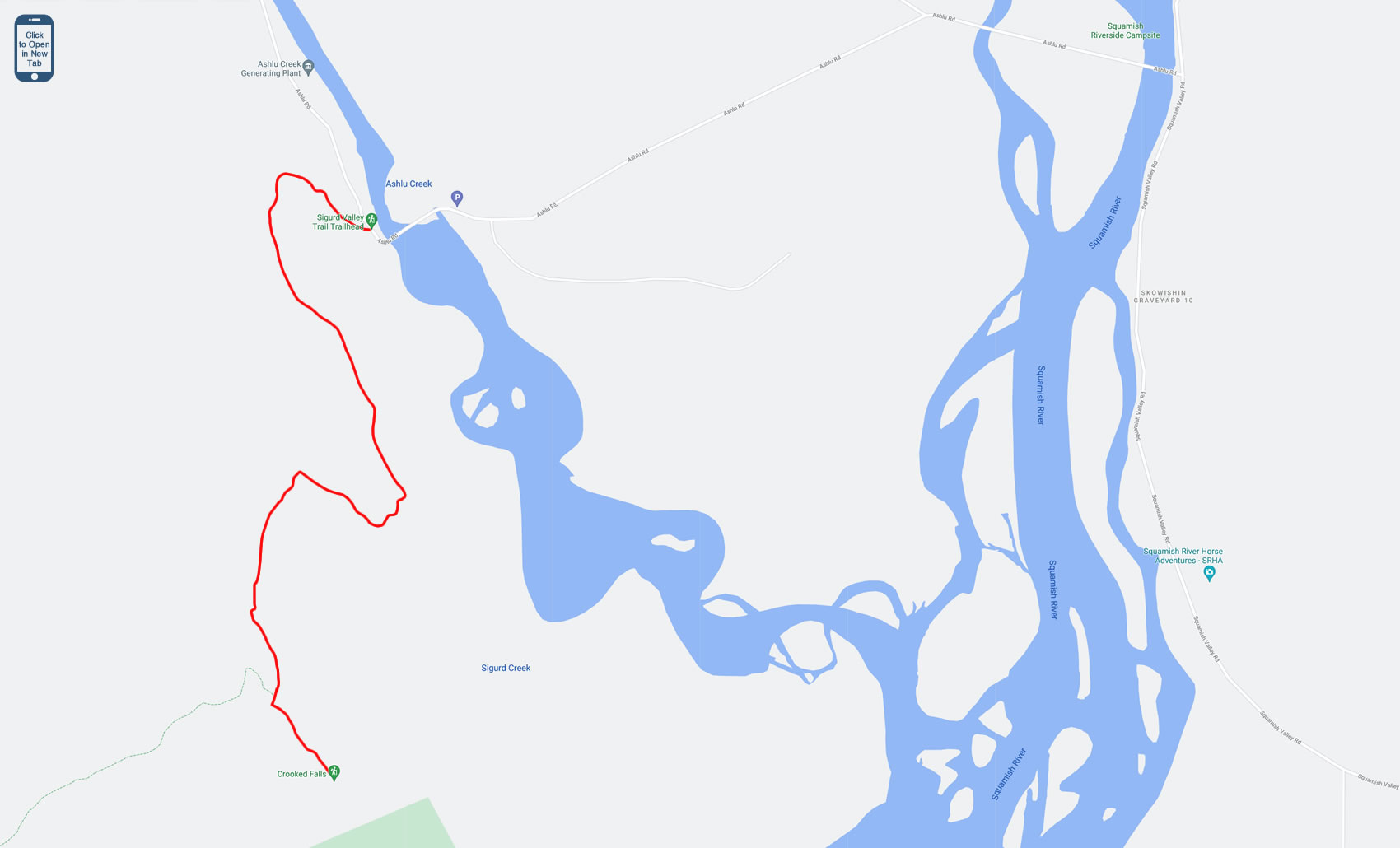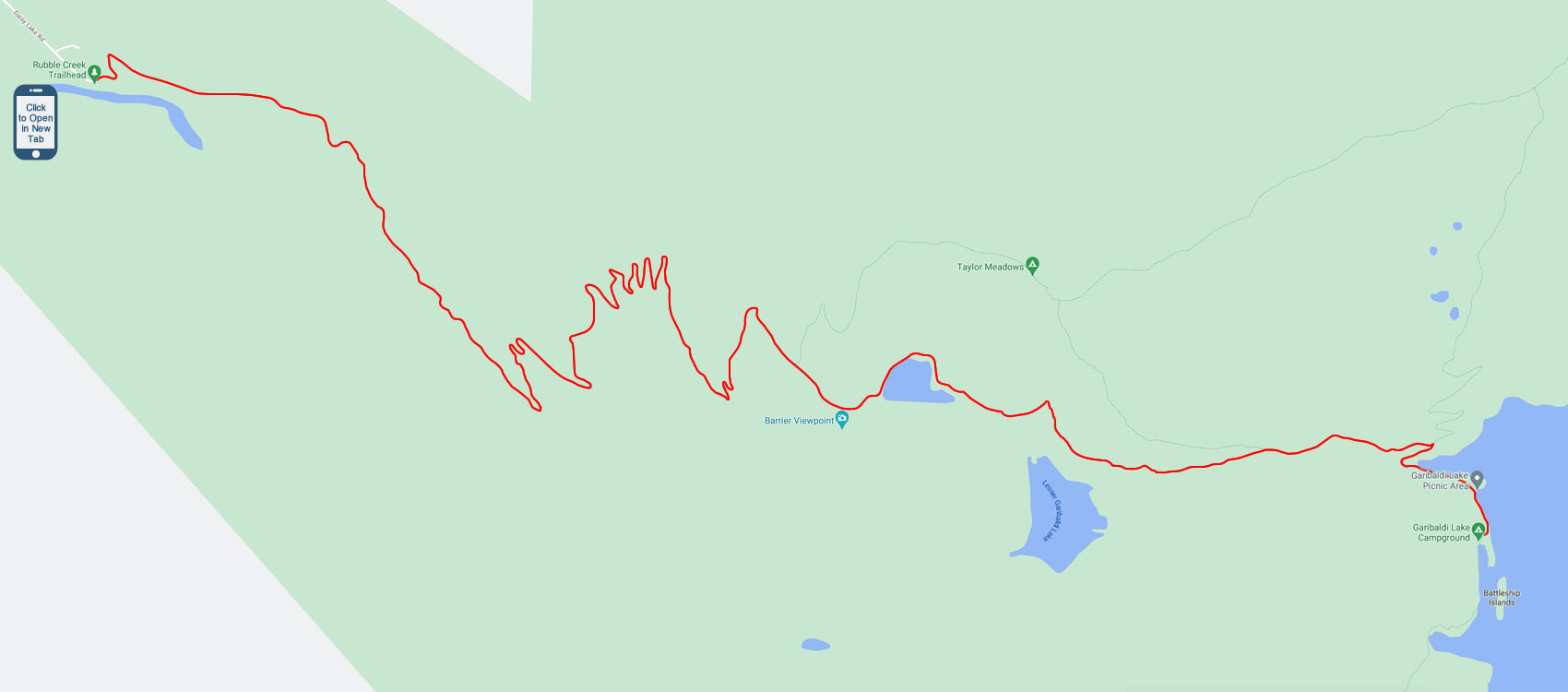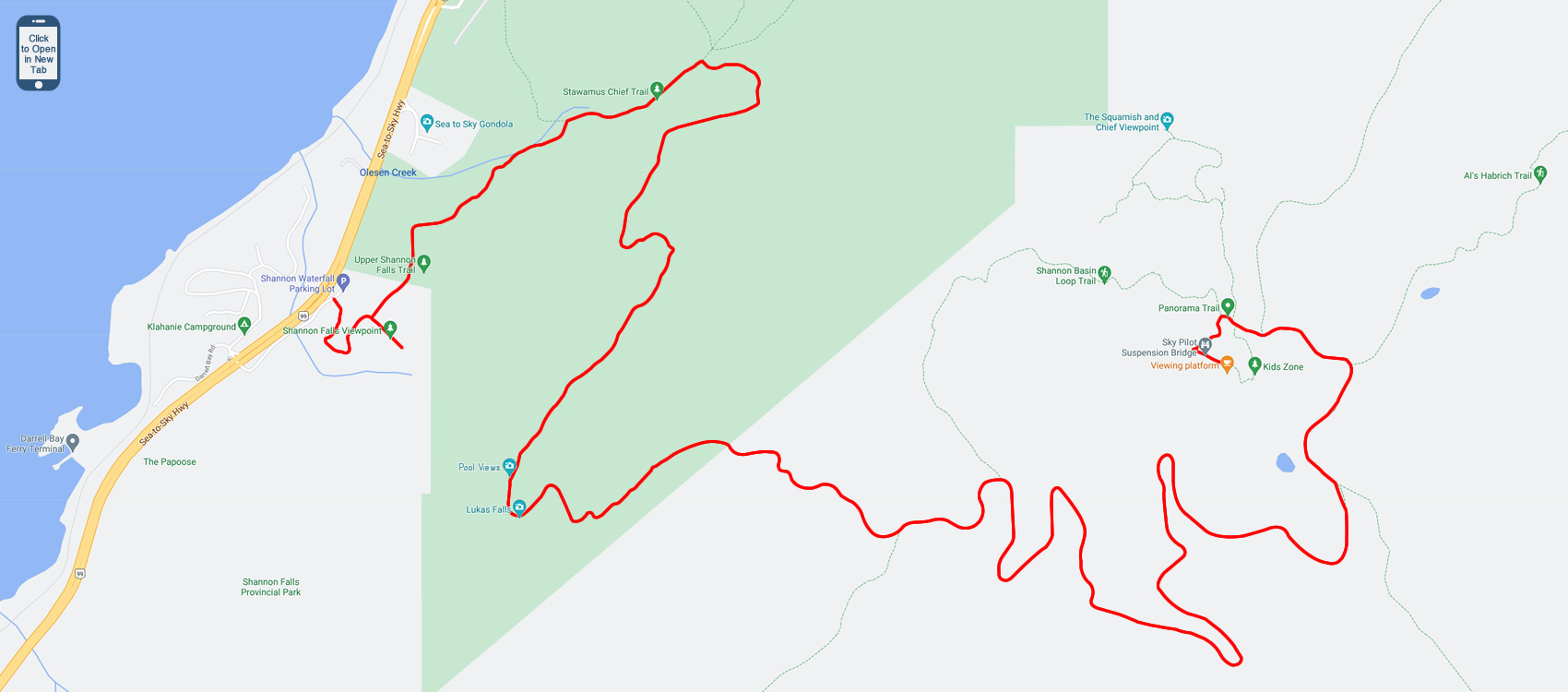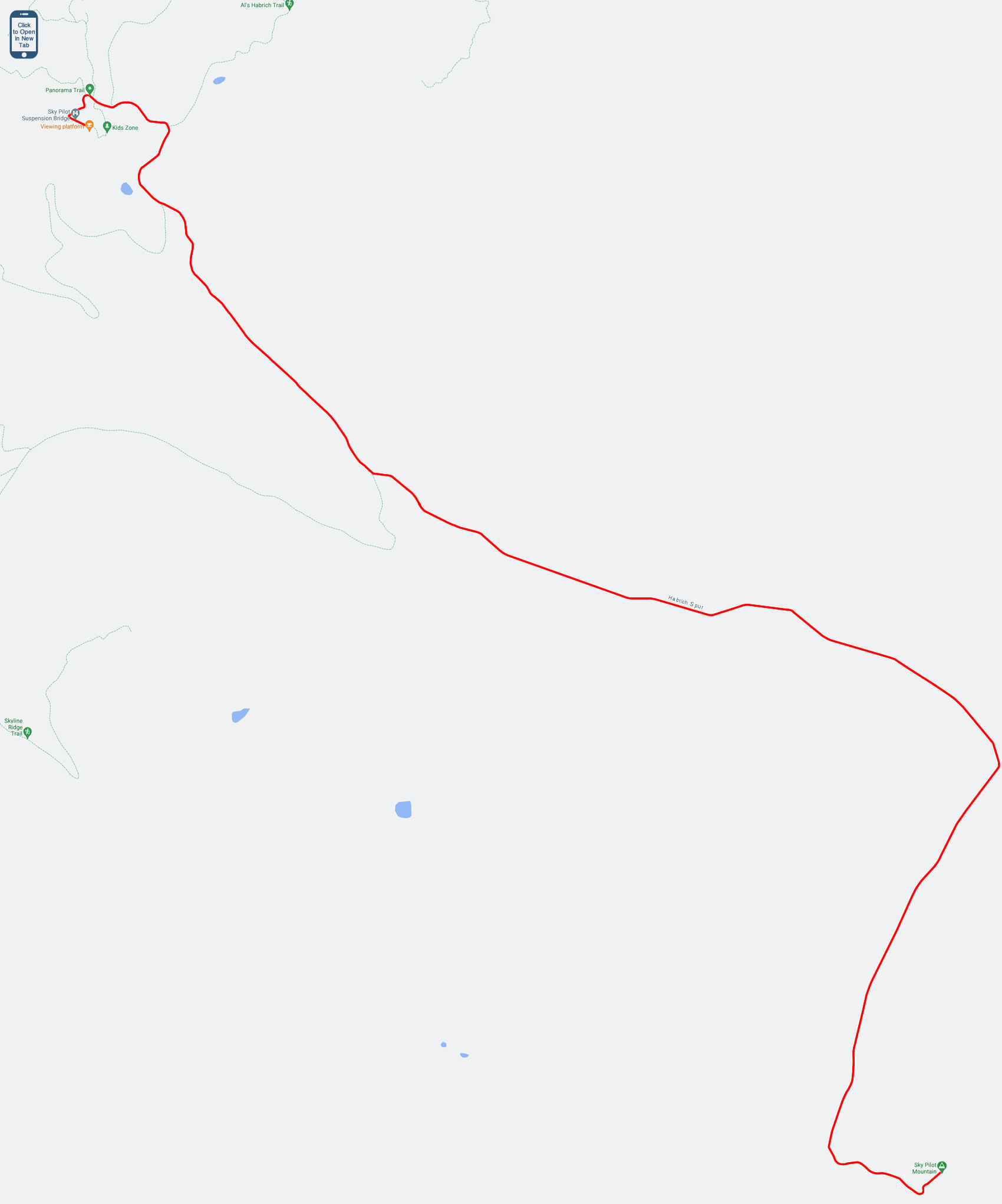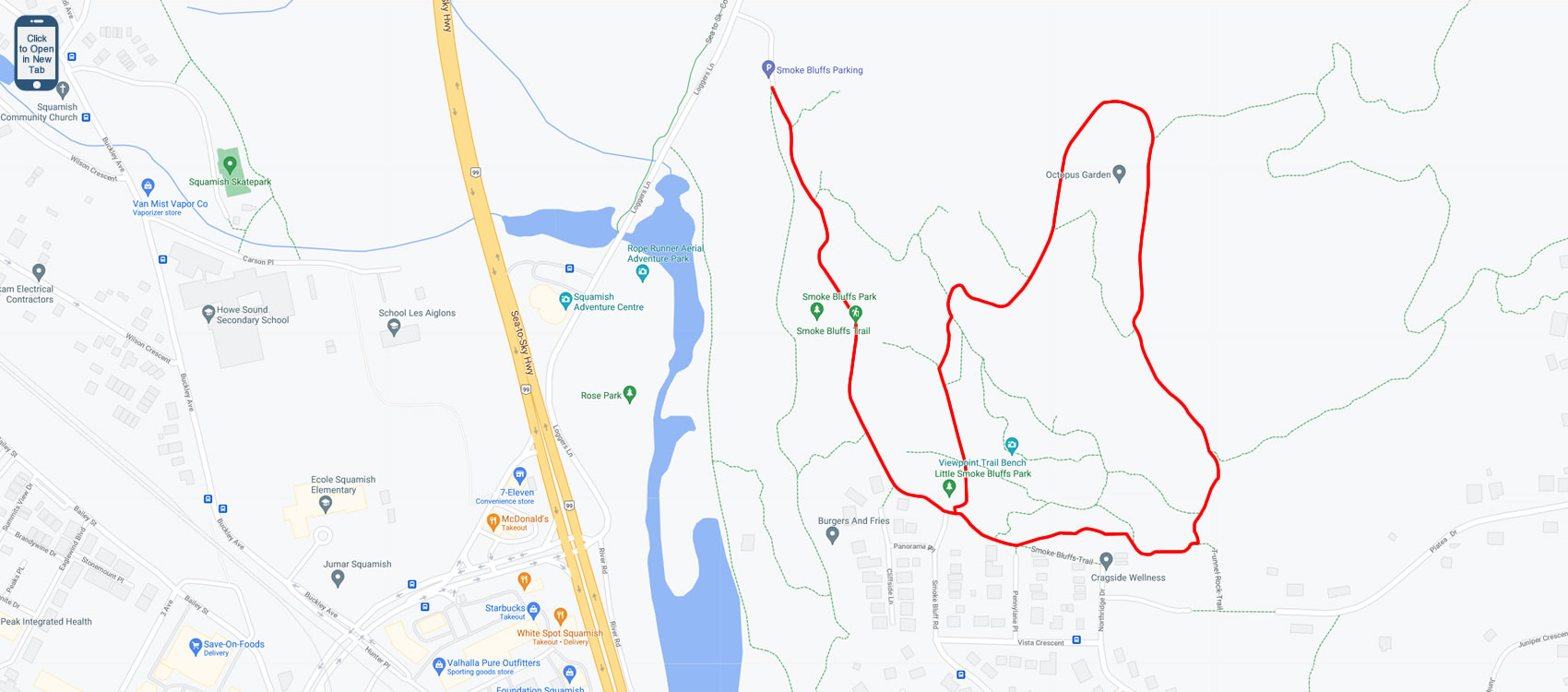
Squamish Trails: Explore the Great Outdoors in Squamish’s Vast Trail Network
This past year has presented some significant recreation and tourism restrictions. Favourite shopping venues, sports and cultural activities have been cut off by government mandates. But we’re in luck; Squamish offers an expansive network of some of the finest hiking trails to be found anywhere.
There have been a few trail closures, corresponding with the temporary closure of Sea to Sky Gondola, and some due to bear activity or Hydro upgrades. Trails closed at the time of this writing include Shannon Basin Loop, Upper Shannon Falls, Sea to Sky Summit Trail and Petgill Lake Trail. Squamish is eagerly anticipating the reopening of the Sea to Sky Gondola late spring or early summer 2021.
Here’s a list of some of the most popular Squamish trails to explore.
Al’s Habrich Ridge Trail
This trail isn’t usually listed as one of those affected by the temporary closure of the Sea to Sky Gondola because the trail begins on the Backcountry Access Road behind the Summit Lodge, and can be accessed from the gravel service road. Hikers take an uphill left just past the water reservoir and then follow the signs to the trailhead. When the gondola is open, hikers will often take the Sea To Summit route from the base of the gondola, take a short break to take in the views from the The Summit Lodge Viewing Deck, and then proceed on the Al’s Habrich Ridge Trail.
The 7 km round trip Al’s Habrich Trail is rated moderate, with an elevation gain of 405 metres, and most hikers can spend anywhere from three hours to a full day exploring. The trail meanders through old growth forest, past creeks, waterfalls, and ancient glacial formations, and across sub-alpine meadows.
The trail offers spectacular views of Mount Habrich, Sky Pilot, and Howe Sound below and ends at marker #44 just past Neverland Lake, with a sign “End of Marked Trail”. While primarily a hiking trail, this four season trail is also popular for nature trips and snowshoeing. An extended trail route takes hikers to Neverland Falls at the far end of the lake.
Brohm Lake Interpretive Forest
Brohm Lake Trail is rated as an intermediate hike, with some challenging sections along the steep rock bluffs that line the lake. Brohm Lake is one of the Sea to Sky Corridor’s warmest lakes during the summer months, and many visitors stop to swim at the various
rock outcroppings along the craggy shores during the summer. The Lake is a popular spot for hiking, swimming, fishing and lakeside picnics.
Archaeological findings in the Brohm Ridge and Squamish River Valley area provide an insight into the historical use of the land and water by the Squamish First Nation, dating back over 10,000 years. The rich ecosystem provided early inhabitants with a wide range of forest products for building and tools, roots for making baskets, and an abundance of wildlife and fish, berries and edible roots, tubers and bulbs.
Brohm Lake Interpretive Forest offers a network of more than 10 km of trails, with the primary trail making a loop around the lake itself. The 3.5 km walking time around the lake for most people is between one and two hours, but with so many additional trails to explore, it’s easy to make a day of it.
The High Trail connects with an old logging road, the Cheakamus Loop Trail provides a picnic area and viewpoint overlooking the Cheakamus River, the Squamish Valley and Tantalus Mountain Range. The Connector Trial and Tantalus View Trail climb steeply to a view of the Tantalus Mountain Range. And the Thompson Trail offers a steep workout and access the Paradise Valley area and Hatchery.
The Brohm Lake parking lot is located 7 km north of Squamish, on the west side of Highway 99. The trails are dog friendly and fairly well marked. Signs at the parking lot and along the trail include maps of every trail in the area.
Coho Park Trails
Coho Park is named after the silver Pacific salmon that spawn in Meighan Creek. Coho salmon prefer to spawn on smaller gravel beds in medium velocity water flow, and that makes the creek a very productive salmon habitat. Meighan Creek flows down from the Garibaldi escarpment, under Hwy 99, to the Squamish River.
Coho Park offers an extraordinary opportunity for visitors to explore a West Coast temperate rainforest ecosystem in an urban area. The moist air from Howe Sound and the Pacific Ocean delivers an average of 279 cm of rainfall to Garibaldi Highlands each year. Tall cedars and other conifers shut out much of the sunshine, which limits biodiversity. This results in a forest floor blanketed by mosses, ferns and many other small plants. Lichen and fungi grow on the tree trunks, deadfall and rocks.
From the trailhead, the path crosses a series of boardwalks to reach a junction at the top of a short hill. Taking the Covenant Trail route to the left will cross two bridges. Most hikers turn back after the second bridge and viewing the beautiful waterfall. The Coho Park trails are popular with hikers, trail runners and boulderers who choose the Trestle Trail at the fork for a selection of popular crags and dozens of bouldering problems and climbs.
The Coho Trail trailhead is located at the end of Parkway Place Road, near Canadian Tire in Garibladi Highlands. There’s a small parking space at the foot of the trail, but if full, more parking is available behind the nearby fire hall. The Coho Trail is 1.1 km out-and-back, but returning on the 4 Play Trail creates a 2.7 km loop. Many hikers continue further north on the Coho Trail and up the escarpment, linking with the vast network of trails in Garibaldi Highlands and Alice Lake Park.
Crooked Falls Viewpoint via Sigurd Creek Trail
The Sigurd Creek Trail to the Crooked Falls Viewpoint is a 6 km out-and-back hike. This dog-friendly trail is rated intermediate, with some challenging sections, and an average round trip hike of between 3 and 3½ hours.
To get to the trailhead, you’ll take the Squamish Valley Road exit left off Highway 99, across from Alice Lake Road. The pavement on Squamish Valley Road will turn to gravel, and there’s a bridge at the 24.5 km mark. After turning left across Squamish River onto Ashlu Road, 1.5 km further there’s another small bridge that crosses Ashlu Creek. There’s a parking pullout just before the bridge. After crossing the bridge on foot, the Sigurd Valley Trail trailhead is on the left side of the road.
Sigurd Creek Trail climbs steeply from the road and soon joins up with a retired forest road. Then, as the logging road levels out the trail turns back into the woods, to form a single track dirt path. After passing a large boulder, and ascending several switchbacks, you’ll come to a junction. Following the yellow sign left leads to Crooked Falls in 300 metres. Crooked Falls is a beautiful waterfall that tumbles over the rocks, and the trail offers several viewpoints overlooking the Squamish River, Howe Sound and the valley.
Echo Lake
The 6.4 km trail up to Echo Lake is one of Squamish’s favourite workouts. There’s roughly 950 metres in elevation gain, from Howe Sound to Monmouth Falls through some of BC’s most beautiful terrain. The trailhead can only be accessed by crossing the Squamish River by boat. During the summer months Squamish Watersports (www.squamishwatersports.com, 778-989-5483) offers a shuttle service across the river. Anyone considering crossing the river by canoe, kayak or skiff should have experience on the water and study the tide charts beforehand.
The trail offers some very unique views of Squamish from the West side, and spectacular views of Howe Sound. At the top, the crystal clear sub-alpine waters of Echo Lake offer a refreshing swim in the summer. The lake is stocked with trout, and it’s a great place to enjoy some quiet family fishing. There are several campsites around the lake, with fresh drinking water and spots for tent camping. The trail can be challenging, requiring scrambling with hand support in places, and is not particularly dog-friendly. A leash is definitely recommended for dog safety.
The mature Pacific Coast rainforest, with some magnificent old growth, is one of the trail’s biggest attractions. The Echo Falls trail is also known as the Monmouth Creek Trail, and runs parallel to the falls. The rushing water has carved deep pools and interesting formations into the ]rocks over millennia. The cooling spray from the whitewater provides enjoyable relief on summer hikes.
Elfin Lakes Trail
Located in the Diamond Head alpine near Garibaldi Provincial Park, the two small Elfin Lakes, and spectacular views of Mount Garibaldi and the valley, make this one of the best hikes in Squamish. The second lake is adjacent to the ranger cabin, a day-use shelter and 35 wood tent pads. The spacious 2-storey backcountry hut is fully equipped, with stove, cooking utensils and bunks for 22. A backcountry reservation permit from BC Parks is required for accommodation, by contacting SCParks.admin@gov.bc.ca.
Diamond Head Trail is a 22 km out-and-back intermediate hike, with an elevation gain of 821 metres. For most hikers it’s a 6 to 8 hour adventure. To get to the trailhead, you’ll take the Mamquam Road exit off the Sea to Sky Highway, past the Squamish Valley Golf & Country course on the right, and then Quest University to the left. The pavement soon ends and the gravel road continues all the way to the Diamond Head Trail Parking Lot. The road is maintained year-round, but during the winter months chains and all wheel drive are recommended. The trailhead begins at the end of the parking lot.
This is an all-day hike, so it’s important to pack plenty of water and food, a headlamp, spare socks and extra clothing layers. The first 5 km of the hike follows a gravel road through old growth forest. The road passes a small waterfall to reach the Red Heather Shelter, a popular rest stop with outhouse facilities. During the winter, it’s a warming hut and there’s often a fire going.
The second 6 km segment of the trail to Elfin Lakes opens up into the sub-alpine, ascending Paul Ridge to 1,660 metres on Round Mountain, with spectacular views of Mount Garibaldi’s peak, the Tantalus Mountain Range and vast alpine meadows. From its highest point, the trail begins a gradual descent, winding its way downward towards the two lakes.
During the summer months the first top lake is the perfect spot to cool off with a swim. The second smaller lake provides drinking water to the ranger cabin, backcountry hut and tent campsite, and swimming is prohibited there. July through September are the best months for avoiding snow, but for many hikers, snowshoers and cross-country skiers, the meadows and trees cloaked in snow have their own special appeal.
Four Lakes Trail
Alice Lake Provincial Park is one of Squamish’s most beautiful settings, located 5 km north of town centre, off Highway 99. Alice Lake is surrounded by majestic mountains, dense rainforests and spacious grassy areas; one of four warm freshwater lakes in the 411-hectare park.
The 6.5 km Four Lakes Trail is a winding loop that connects Alice Lake with Stump Lake, Fawn Lake and Edith Lake. It’s wide, easy and well marked, with an elevation gain of 146 metres. Most hikers complete the loop in 2 to 3 hours.
There are two trail access points, one at the Alice Lake south beach area and the other Stump Lake parking lot. The forest is made up of both coniferous and deciduous trees, with plenty of Douglas fir and western red cedar. An abundance of wildlife inhabits the park, and visitors often spot squirrels and chipmunks, raccoons, box turtles, Steller’s jays, chickadees and robins.
Deer, bear, coyote, cougar and bobcat are also in the area, so dogs must be kept on a leash. The four lakes are stocked with trout, but fishing is suspended during the mid-May through September swimming season. The swimming is great in all four lakes, although Alice Lake has docks and designated swimming areas.
Ten trails branch out from the park, with various destinations, including Garibaldi Highlands, Garibaldi Provincial Park, the Alice Ridge Forest Service Road and the gruelling 3 km DeBeck’s Hill Trail. Highlights of the DeBeck’s climb are the old steam donkey once used for yarding logs and breathtaking views of the ice-capped Tantalus Range.
Garibaldi Lake Trail
Situated in a deep subalpine basin at 1,450 metres, in beautiful Garibaldi Provincial Park, Garibaldi Lake is surrounded by alpine meadows, snow-capped mountains, glaciers and volcanic outcrops. There are volcanoes along the north, west, and south sides of the glacial lake, and non-volcanic peaks bordering its northeast and eastern shores. Glacial flour suspended in the meltwater, from the Sentinel Glacier to the south, and Sphinx Glacier to the east, give the water it’s lovely turquoise colour.
The waters of the lake were dammed by a lava formation known as The Barrier, flowing from the volcanoes of Mount Price and Clinker peak to the south. This impressive lava dam is roughly 2 km in length and 300 metres thick. There’s a series of lava outcrops along the northwestern shore that form what is referred to as the Battleship Islands. The main access route to the lake is via the Garibaldi Lake Trail but some hikers take the Taylor Meadows Trail route.
The 21.2 km out-and-back Garibaldi Lake Trail typically takes between 6 and 8 hours to hike. It has a 1,012 m elevation gain and is rated moderate. Roughly 30 km north of Squamish, and south of Whistler, you’ll turn right onto Daisy Lake Road, which ends at the Rubble Creek Trailhead where Garibaldi Lake Trail begins.
The trail is well marked and begins with a steep climb through the woods above Rubble Creek. Shortly after the trail levels out at around 6 km, there’s a junction and you’ll probably continue straight, following the banks of Upper Rubble Creek. You’ll follow the banks of Upper Rubble Creek until you reach Battleship Islands on the west end of Garibaldi Lake. Turning right at the junction leads directly to the lake, for a shorter hike. And turning left offers an extended alternate route through Taylor Meadows.
Garibaldi Lake Trail is popular for hiking, trail running, snowshoeing and backpacking, and is used most from April until November. The trail reopened September 2020 an a pass is required to access it. Pass information is available at bcparks.ca/explore/parkpgs/garibaldi/. There are campgrounds and day-use shelters on the western shore of Garibaldi Lake, as well as Taylor Meadows. Tent platforms protect the ecosystem and pre-registration is required to use the campgrounds.
High Falls Creek Path
The High Falls Creek Path is a 12 km round-trip loop trail located north of Squamish. There is some challenging terrain, that requires a bit of rock scrambling, with an elevation gain of 650 meters. For most hikers the trail takes 4 to 5 hours return, and it’s rated as difficult. There are ropes to provide assistance in some of the steepest sections.
The best months to hike the trail are May through November. When it’s wet or icy the trail becomes quite slippery, and it’s best to choose a dry, sunny day. The best time of day to hike the trail is late in the day, when the sun is shining directly into the canyon. There’s a short side path that leads to a fantastic view of the falls and the canyon wall on the other side. Another 20 minutes of climbing and the trail arrives at an expansive view of the falls, and a very interesting large boulder that became wedged between the granite walls of the canyon.
The trail boasts some of the most beautiful scenery in Squamish, with spectacular views overlooking the falls, the Tantalus Range and Squamish Valley. High Falls Creek is a steep, box canyon that empties into the Squamish River. The trail ends on a logging road above the canyon, and many hikers choose to turn left on the road and walk the 5.5 km back down to Squamish Valley Road. While not as interesting terrain, the road does offer excellent views of the Squamish and Elaho Valleys.
To get to the trail, you turn left off Highway 99, opposite Alice Lake Provincial Park, onto Squamish Valley Road. In 4 km you will bear left and stay on Squamish Valley Road. The second small bridge you come to crosses over High Falls Creek. You can park just before the bridge, and walk across. The trailhead is on the right, after the bridge, marked by a sign.
Mamquam River Trails
Some of the most popular family trails in Squamish follow both banks of the Mamquam River.
The big seasonal attraction is the salmon run, and the eagles that arrive to feed on the fish. Every year these channels fill with Coho Salmon and Steelhead arriving from the Pacific Ocean. Depending on the section(s) of trail chosen, the spawning channel trails range from 1 to 4 km and take between 1 and 2 hours to walk. Mamquam is the Squamish Nation word for “smelly river”, which it is while the spawned out salmon carcasses are decaying on its banks.
These easy trails are accessible all year round and are dog-friendly; but dogs must be on a leash. The trails are popular with families on a walk, trail runners, mountain bikers, horseback riders and anglers.
On the north bank, between the Squamish Golf and Country Club and the Mamquam River, there is a network of trails that meander through the Mamquam River spawning channels. The flat trails through the shallow channels range from two wide gravel paths to narrower single-track earth paths that branch out from the main trails.
The north bank trail network can be accessed from a parking lot on the south side of Mamquam Road just east of the Squamish Valley Golf & Country Club, or by parking at the Mamquam River, then crossing Government to connect with the trail on the dyke. To park at the river dyke you’ll turn left off Government Road, just after the Mamquam River bridge, onto the short road, and follow it to the gravel parking area at the dyke, past the municipal services yard and dog pound.
The south bank spawning channel trails can be accessed by turning right onto Centennial Way, off Government Road, instead of crossing the Mamquam River bridge, and following Centennial past the Mamquam River Campground. There’s a small gravel parking lot on the left side of the road just before the Coast Aggregates gravel pit gate. In addition to a network of trails and bridges, there’s an island and large gravel bar to explore. The network of dyke trails follow the south shore of the Mamquam River to Brennan Park Recreation Centre.
The third option is the Mamquam north shore dyke trail network. The trails are accessed from the dyke parking lot west of the Mamquam River bridge. There’s a wide gravel path that heads east from the parking lot, with many offshoot dirt trails on both sides.
Mount Crumpit Loop Trail
Mount Crumpit is a 331 metre peak near the Stawamus Chief, located in a network of trails known as The Crumpit Woods. Trails in the Crumpit Woods are shared by hikers, mountain bikers and trail runners, so it’s important to keep your eyes open for bikers. This forest trail offers excellent views of the town of Squamish, Stawamus Chief, Atwell Peak and Howe Sound.
The trail is rated as difficult and some scrambling will be required in steeper rocky sections, with and elevation gain of 263 metres. The average time is about 3.5 hours, and it’s a dog-friendly trail. To access the trail, turn East off Hwy 99, then left onto Westway Avenue. You can park near the intersection of Westway and Cherry Drive, being considerate of the local residents.
On the standard 6 km clockwise loop, from the Westway Avenue trailhead, you’ll enter the forest, cross a bridge and almost immediately turn left. The trail will cross some boardwalks, and then you’ll turn right at the junction onto the S&M Connector Trail. The trail will pass through a small valley to the first junction, and you’ll stay on the S&M. About 1 km further, there’s a second junction, where you’ll turn right onto the Fatherside Trail.
It’s a good idea to use a GPS trail app like Trailforks, TrailMapps or AllTrails, or use the 105 Hikes guide book, because this section of the trail isn’t very well marked. There will be several more junctions, but it’s important that you stay on the Fatherside Trail. You’ll turn right at the first junction, and a sharp left at the second. The trail will then climb gradually for a while, then take a slight dip, before gradually bearing right. You’ll soon arrive at a four-way junction. After the junction, keep an eye out for a trail that veers right, with a sign labeled Woodpecker Trail.
Woodpecker Trail is a steep ascent up the side of Mount Crumpit. After climbing for about 15 minutes, you’ll reach another junction. If you turn left there’s a trail to a viewpoint that looks north over several mountain ranges. Returning to the junction, you’ll continue on Woodpecker Trail until the next junction. Here you choose from two routes. You’re going to turn right. After another 5 to 10 minutes you’ll come to yet another junction.
To enjoy the viewpoint turn left. Within a few minutes you’ll emerge from the forest onto a bluff, with stellar views of the Stawamus Chief and the Mamquam Forest Service Road. Returning to the junction, you’ll continue on the trail until it ends at the base of a short but steep rock scramble to the top. From the peak, you’ll have great views of The Chief and Howe Sound. The trail continues to another junction, where you’ll head left at the junction, wrapping around the mountain to another viewpoint. From that viewpoint you can hike left to the actual summit of Mount Crumpit. However, the summit is a bit of an anticlimax, hidden in the trees.
After enjoying the viewpoints, continue on the trail and it will soon begin to descend steeply. You’ll bear right at the first junction, and continue to a second junction with a sign for Deep Ends Trail. Deep Ends will take you back down to the S&M Connector, which you can take back out to the trailhead.
Mount Mulligan Trail
Mount Mulligan is a peak located in the backcountry behind the Stawamus Chief. The trail is known for its fantastic views of Howe Sound, Mount Garibaldi, Garibaldi Provincial Park, Mount Habrich and the Sky Pilot Massif. The 15.3 km trail is rated as medium to difficult, and most visitors can complete the out-and-back hike in 4 to 6 hours. However, most hikers make a day of it. The trail has an elevation gain of 1,136 metres, and backcountry downhill skiing during the winter months is popular. The trail is also a favourite with snowshoers.
To get to the trailhead, turn onto the Mamquam Forest Service Road (FSR) just south of Squamish. You’ll want to check your odometer and then continue along the road for 7 km, making a right turn onto the unnamed forest road. Depending on the time of year and conditions, 2-wheel drive owners may have to park at the foot of the steep road and hike up to the trailhead. With 4-wheel drive, most vehicles should be able to drive the 2.5 km to the upper parking lot.
From the trailhead, the trail begins on a deactivated logging road through the forest until it opens up to a large alpine meadow. Mount Mulligan can be seen to the left from the meadow, and Anif Peak to the right. The trail continues to the left, back into the trees, upwards to the forested summit at 1,534 metres.
Murrin Park Loop and Browning Lake Trails
Murrin Lake Provincial Park is located 9 km south of Squamish on Highway 99. The park is centered around Browning Lake and offers a spacious family picnic area with BBQ pits, swimming and fishing. It is also known for its rock climbing crags and 2 primary hiking trails.
The Browning Lake and Jurassic Ridge loop trail is 2.4km and has an elevation gain of 162m. This moderate trail winds its way around Browning Lake. There are some steep sections on the Jurassic Ridge, with rope assists and open rock slabs to navigate, so shoes with good traction are recommended. The highlight of the Jurassic Ridge hike is the Quercus Viewpoint with spectacular views overlooking Howe Sound and Browning Lake.
Murrin Park Loop Trail is a 1.8 km loop that meanders through the crags and viewpoints of Murrin Park, with an elevation gain of 130 metres. Notable climbing walls to see are the Bog Wall, Leviticus, Petrifying Wall, Shaman, Sugarloaf and The Brunser. This shorter loop is also known as the Quercus Trail and includes some excellent views. The trail is rated intermediate and takes most hikers between 1 and 2 hours.
Oceanfront Interpretive Trail
The Squamish Oceanfront Interpretive Trail wraps around what was once a large industrial development on the peninsula along the Squamish waterfront. When the Squamish Terminals were built across Cattermole Slough, the Oceanfront Lands became a recreational area locally referred to as Nexen Beach. Squamish residents have seen significant changes as Oceanfront Squamish began its development; but the loop trail is still here, but with a new name: Oceanfront Interpretive Trail. And the beach has been rebranded: Newport Beach.
The Oceanfront Interpretive Trail trailhead begins at the end of Cleveland Avenue. There’s a gravel parking lot across from Howe Sound Inn & Brewing. The out-and-back trail is 2.4 km in length, is rated as easy, and takes about an hour. The flat wide-track gravel trail follows the estuary to an expansive sandy beach on Howe Sound. When the tide is out there’s plenty space for children and dogs to run and play.
The beach offers views of Howe Sound, the Stawamus Chief, Shannon Falls, snow-capped Mt. Murchison and other surrounding mountains. Sailboats can often be seen heading out into the sound, or returning back to their Squamish Yacht Club mooring.
On the east end of the beach, just after the Galbraith Avenue access road, the trail picks back up again, following Galbraith and the shore of the Mamquam Blind Channel. Galbraith Avenue makes a dogleg to the right, and the trail makes a hard left to cross the road at that point, circling back to complete the loop. At the junction where the loop is completed, turning right will take you back to the trailhead and parking lot.
The trail is dog-friendly, and the beach is traditionally considered off-leash by local residents. It’s common to see grey heron, the occasional owl, other birds and squirrels along the Oceanfront trail. And orcas, seals and dolphins have been spotted in the sound.
Panorama Trail
Panorama Trail is a 1.8 km year-round single-track forested loop trail with majestic views of the Stawamus Chief, Howe Sound, and the Squamish Valley. The terrain is easy to navigate for all ages and hiking levels, with an elevation gain of only 30 metres, and the loop can be completed in under an hour. Cedar benches have been placed along the path, to rest or take in the view.
The trail offers several wooden bridges and the Chief Overlook Platform, and the option of crossing the Sky Pilot Suspension Bridge. The Chief Overlook Platform is a cantilevered deck that extends over a sheer drop, offering unimpeded views. If you plan to complete the Panorama Trail during the winter, remember to bring along a pair of snowshoes.
The easiest way to get to the trailhead is to ride the Sea to Sky Gondola up to the Summit Lodge. The Sea to Sky Gondola Base Camp is located 4.4 km south of Squamish on Highway 99. Tickets at the time of this writing are $55.00 for adults, $50.95 for seniors, $32.95 for youths and $18.95 for a child.
The alternate route to the Panorama Trail is hiking the Sea to Sky Summit Trail. The Sea to Summit Trail will take you from the from the Sea to Sky Gondola Basecamp, the Shannon Falls parking lot, or Stawamus Chief parking lot, all the way to the Summit Lodge. Perhaps the most popular of the three routes, starting at the Sea to Sky Gondola parking lot allows hikers to return back to the parking lot by gondola if the hike up was enough exertion for the day. There are even ‘Buster the Dog’ ride down passes available for dogs, for $14.29.
The Sea to Summit is an intermediate trail with a few steep sections. It shares lower sections with the Stawamus Chief Trail. There are 162 numbered blazers on the Sea to Summit path and at blazer 20 – the 1km junction marked by a large boulder – you will turn right, leaving the Stawamus Chief Trail. The trail will travel under the gondola and traverse toward Shannon Creek, which feeds into the falls. If you brought a dog, you’ll want to attach a leash as a safety precaution, due to the rushing water.
About half way to the Summit Lodge, there’s a spectacular viewpoint overlooking Howe Sound and across the Coast Mountains. You will continue to follow the trail markers until you reach a junction. Cross the Shannon Basin Loop trail and continue upwards, again following the Sea to Summit markers. The trail traverses under the gondola and then upwards to the Summit Lodge. You may wish to take a well-deserved break before continuing on the Panorama Trail.
Petgill Lake Trail
The Petgill Lake Trail is a 9.5 km loop to a quiet, mountain lake and viewpoint. The trail is rated intermediate, has an elevation gain of 650 metres, and most hikers take 5 to 7 hours to complete it. The trailhead is located 100 metres north of the Murrin Provincial Park parking lot, on the opposite side of Highway 99. Be very careful when crossing the highway; the cars are travelling at 80 kph.
The single-track trail rises steeply into the dense forest for the first 1.5 km, requiring some scrambling and the use of your hands. There are fixed ropes and chains to provide assistance on some of the steepest sections. There are several excellent viewpoints in the first section. The trail will then descend quickly to join a wide, deactivated logging road with a gentle initial grade, which will later ascend through several switchbacks. You’ll cross over two creeks, although they may only be a trickle during the summer months.
About ten minutes past the second creek, it’s important to keep your eyes open for the orange flags that indicate your departure from the old overgrown logging road, where the trail will reenter the dense forest to the left.
The trail will follow a series of granite ridges as you get closer to the lake. The terrain varies a lot, taking you on series of roller coaster ascents and descents. At one point you’ll climb over a rock outcrop and next you’ll scramble down a steep narrow trail between two gigantic boulders. You’ll eventually come to a junction, and will take the left trail. Petgill Lake will soon come into view from the ridge you’re on, and you’ll continue on the trail as it descends down towards the lake shore. Another popular option is to scramble over the rocks to get down to the lake.
If you hike another 10 minutes beyond the lake you’ll arrive at a viewpoint that offers a majestic 180 degree view of Howe Sound, Mount Sedgwick and the Tantalus Mountain Ranges.
Shannon Falls Trails
Shannon Falls is the third highest waterfall in British Columbia. Beginning at the the Stadium Glacier and alpine massif below Sky Pilot Mountain, Shannon Creek falls 335 metres, over granite cliffs, to the valley below. Spring is the best time to view the falls, when the water is flowing at full force. Shannon Falls Provincial Park is located 1 km south of Squamish, just off Highway 99. There are three main trails: the short hike from the parking lot to the base of the falls, the connector trail to the Stawamus Chief, and the upper falls trail.
Shannon Falls Park has a popular picnic area and BC Parks kiosk, located next to the parking lot and Shannon Creek. The 1 km Shannon Falls Lookout loop trail begins just off the parking lot, and winds its way through old growth Douglas Fir, Western Red Cedar and Hemlock trees. There are viewpoints along the way and a viewing platform at the falls. Dogs must be kept on a leash.
The Connector Trail connects Shannon Falls with Stawamus Chief Trail. 6.4 km in length, the out-and-back trail has an elevation gain of 687 metres, and is rated intermediate. The trail passes through old growth forest and offers some excellent views of Howe Sound. The highlight of the trail is the bridge over the rushing creek, with its unhindered views. The Connector joins the Stawamus Chief Trail near the top of the dreaded wooden stairs.
If you want to continue with the Upper Shannon Falls Trail, you’ll turn right after the Connector Trail’s bridge, onto the Stawamus Chief Trail. The full Upper Shannon Falls Trail, from the Shannon Falls parking lot and back, is 14 km, with an elevation gain of 450 metres. After the stairs, you’ll hike upwards until you reach a major junction, marked by a large boulder and signposts. You’ll turn right onto the Upper Shannon Falls Trail/Sea to Sky Summit Trail.
It’s a steep, challenging route with rocks, roots, some scrambling, and very few flat stretches. There will even be a few sections with ropes and chains for assistance. You’ll catch the odd glimpse of Howe Sound and Upper Shannon Falls between the trees. The sound of rushing water will become louder, and louder, until you find yourself standing on an outcrop overlooking the spectacular Upper Shannon Falls, with a light spray in your face.
Sky Pilot Trail
The Sky Pilot Trail is a 17.9 km out-and-back intermediate trail with an elevation gain of 1,243 metres. The trailhead for the Sky Pilot Valley Trail begins at the Sea to Sky Gondola. Take the Backcountry Access Road and follow the markings for Sky Pilot Valley Trail at the end of the road. You’ll follow the Valley Trail that lies below Mount Habrich until the end at the tree line, near the base of Sky Pilot Mountain.
The Valley Trail is a gentle hike with a 350 metres elevation gain, and excellent views of Sky Pilot and, across the valley, the Goat Ridge. Many hikers turn back at the tree line, for a 10km round trip. The Sky Pilot Valley Trail – gondola to the tree line and back – takes most hikers between 3 and 4 hours.
To continue on the Sky Pilot Trail, you’ll follow the ribbon markers over a creek and into the woods. You’ll then traverse a rock slide valley to approach Stadium Glacier. The most popular route to the summit is via the West Buttress. Things become technical here, requiring light mountaineering and some climbing skills in high-alpine, glaciated terrain.
Crampons, boots and mountaineering axes are recommended year-round for ascending the glacier. The glacial ice is steep and self-arrest skills should be considered essential. It’s a good idea to practice some self-arrests near the foot of the glacier, before ascending.
After climbing the glacier, you’ll find yourself on a ridge. Follow it left towards the 50-metre face known as the Pink Slab, which involves some ‘low Class 5’ climbing. Some belay rings are installed at the top. If you have climbers in your group who would feel more comfortable rappelling down, there they are. After Pink Slab the markers will become more sparse. The summit push involves scaling two sub-peaks, navigating around towers and scrambling up two ‘high Class 4’ chimneys, on the way to the 2,031 metre summit.
The Sea to Sky Gondola is open until 6pm, or 8pm on Fridays and Saturdays, so it is possible to complete the climb in a single day. If you are planning to stay on the mountain overnight, consider taking the shuttle from Squamish to the Sea to Sky Gondola, or driving up the Mamquam Forest Service Road.
Skyline Ridge Trail
The 24 km out-and-back Skyline Ridge Trail typically takes 6 to 8 hours return and is rated advanced; perfect for hikers who like to push their limits a bit. This all-day hike takes a direct line between Sky Pilot and Goat Ridge, with a 700 metre elevation gain.
The trail offers spectacular views of Goat Ridge, Mount Habrich’s granite dome, the peaks of Sky Pilot Mountain, Howe Sound, the Stawamus Chief, stands of old growth forest, cut-blocks and expansive alpine meadows sprinkled with wild flowers.
Like the Sky Pilot Trail, your hike begins at the Sea to Sky Gondola. You have the option of riding the gondola up, or hiking the Sea to Sky Summit Trail. To access the Skyline Ridge Trail you’ll take the Backcountry Access Road (Shannon Creek FSR) about 6.5 km. At trail marker #1, you’ll turn right, descend and cross the Shannon Creek bridge. Then, at the next fork you’ll bear left and begin to climb the west side of the ridge.
The trail rises slowly through open forest, around ponds and bluffs, between benches, and through meadows and talus. This trail offers a mix of old overgrown logging roads, single-track dirt trails, rocky and root-covered paths, and a few steep sections that require scrambling.
Smoke Bluffs Park Loop Trail
The Smoke Bluffs Trail begins at the parking lot at the entrance to Smoke Bluffs Park. At the 4-way intersection of Cleveland Avenue and Highway 99, take Logger’s Lane indicated by the Rose Park sign; which immediately turns hard left and then back right, passing the Squamish Adventure Centre on the left. Keep your eyes to the right side of Logger’s Lane, and after passing an industrial yard, you’ll come to Smoke Bluffs Park, roughly 500 metres north of the Adventure Centre.
At the south end of the parking lot there’s a wooden map board, picnic tables and the trailhead. You can also pick up a map at the Squamish Adventure Centre. The primary loop is 2.7 km round trip, but the network of trails branch out in a large fan, meandering through the many climbing areas, while offering great views of the town of Squamish, the Stawamus Chief and Howe Sound.
The loop has an elevation gain of 123 metres, is rated easy-through-intermediate, and takes between 1 and 1½ hours. But exploring all the trails and climbing walls can easily make it a 3 to 4 hour adventure. The main gravel trail climbs steeply from the parking lot. Be sure to select the “Pedestrians Only” trail at the base. It’s common to encounter downhill mountain bike riders blasting down the “Bike Route”, so the right side trail is best avoided.
You’ll pass the Smoke Bluff Wall on your left, and then continue to the Neat and Cool rock climbing area. Then, as the trail begins to level off, you’ll reach the Little Smoke Bluffs Park children’s playground with some picnic tables. There’s a junction just on the other side of the playground, and the Loop Trail begins by turning left.
The Loop Trail begins as a steep, narrow gravel path. After a few minutes you’ll come to a junction, and you want to select right, and the Upper Loop Trail. Your ascent will continue and soon you’ll reach another junction. You will again select right. You’ll pass through several switchbacks and then reach a third junction. Again, choose right to begin the Upper Loop. You will almost immediately come to the first viewpoint, with a bench. The view overlooks Howe Sound and some of the industrial part of Squamish.
As you continue on the trail, it won’t be long before you reach the second viewpoint, on a large dome of granite. Here you’ll have views of Howe Sound below, and the Stawamus Chief monolith towering above. A few minutes later you’ll arrive at the third viewpoint. The south-facing viewpoint is smaller, and provides a view of the Sea to Sky Highway below.
The trail will continue to circle around, passing several more climbing areas. Soon you’ll be back at the junction where you joined the Loop Trail. You’ll retrace your route back to the parking lot. Smoke Bluffs Park is a dog-friendly area, but dogs must be on a leash.
Squamish Estuary Trail
The Squamish Estuary is made up of the land and waters west of the railway tracks. The main Squamish Estuary Trail is a 3.2 km loop, with a 9 metre elevation gain, located right at the edge of Downtown Squamish. Most of the trail is just 1 to 3 metres above sea level, and its flat terrain makes it an excellent walk for people of all ages. It’s particularly popular with families, dog owners and trail runners. Dogs must be kept on the leash at all times in the Skwelwil’em Estuary Wildlife Management Area.
The estuary is also used by water lovers like kayakers, paddleboarders, kiteboarders and anglers. Bird watchers are drawn to the tidal mudflats, marsh meadows, wetlands and spruce and alder forest to see and listen to birds such as ducks, geese, Trumpeter Swans, crows and Belted Kingfisher. Some of the mammals you might spot are black bear, cougar, coyote, black-tailed dear, moles, rabbits and vole. The trail offers views of the Stawamus Chief and Shannon Falls, Howe Sound and surrounding snow-capped mountains.
In addition to the loop trails, there are other Estuary Trails in its network: Chelem Trail, Old South Dike Trail, Town Dike Trail, Waterfront Trail, and Woodpecker Trail. Locating and exploring all of the trail sections can easily become a half-day adventure.
To access the trail, most people park on 5th Avenue, near the roundabout at the corner of Main Street and 5th. A gravel road – closed to traffic by a gate – leads from the roundabout to the gravel dyke trail. You will turn left onto the dyke connector trail, and within 50 metres turn right onto the wooded trail leading to the railway tracks. There’s a nice view of The Chief and Shannon Falls at the junction. After crossing the tracks you will see the yellow and blue Skwelwil’em Estuary Wildlife Management Area sign at the left side of the trail.
The Blue Heron Trail and Squamish Estuary Trail Network begin at the sign. After roughly 10 minutes of walking you’ll come to a junction. Straight ahead there’s a narrow single-track path that goes to Howe Sound, but you’ll want to turn right onto the Swan Trail. There’s a rest bench and interpretive sign board right after the turn. The terrain in this section is made up of large expanses of marshland, wetlands and tidal mudflats.
There are three bridges and two rest benches on the Blue Heron and Swan Trail segment. The Swan Trail offers excellent unobstructed views of the Stawamus Chief. For much of the year the marshland will be sprinkled with wildflowers, with a backdrop of bullrushes and other wetland sedges. Just before the second bridge, there’s access to the clearest water on the trail, and it’s a popular spot to let the dog take a dip. Depending on the tides, it’s usually a mix of fresh and saltwater, so dogs shouldn’t drink too much.
The trail will soon make a 90 degree turn right and the third bridge will come into view. There’s a junction just after the bridge. You can keep straight on the Swan Trail, for the full loop experience, or turn right onto the Old North Dyke Trail, to take the short loop.
The Old North Dyke Trail option is less than half the distance of the full loop, and is perhaps the more interesting choice, with a technically challenging root-covered single-track path through a bog, with several bridges and boardwalks, and burl ‘pavers’ to assist in stepping over the mud near its end. When you reach the tracks, turn right onto the railway service gravel road and in about 5 minutes you’ll be back at the big yellow trailhead sign.
If you chose to continue on the Swan / Catermole Creek Trail route you’ll walk on a relatively flat gravel trail under a canopy of spruce and alder trees. You’ll be following the water of the inlet to your left, and it’s common to see waterfowl and paddleboarders in the channel. After about 15 minutes, you’ll reach a junction and you want to turn right towards Bailey St. You will then turn right again onto Bailey and walk on the gravel road for about 100 metres, before turning left back into the woods, on the Cattermole Creek Trail.
Cattermole Creek Trail is a single-track path that takes you through some lush old growth forest on the way to the railway service road and the tracks. You’ll turn right onto the gravel road and within 10 minutes you’ll be back at the big yellow trailhead sign. Turn left to take the gravel trail back towards the roundabout and your parking location.
Stawamus Chief Hiking Trails
The Stawamus Chief is the world’s second largest granite monolith, rising 541 metres above Howe Sound. (The Rock of Gibralter, off the coast of Spain, is the largest.) Squamish’s most notable landmark, ‘The Chief’ has three distinct summits, all accessible from its main Chief Hiking Trail. The trail is not very technical, but it can be physically demanding, so it has been rated as intermediate. On the first and second peaks there are chains and steel ladders to provide assistance in a few steep or challenging parts.
2.8 km south of Downtown Squamish, turn off Highway 99 into Stawamus Chief Provincial Park. After parking your car, you’ll turn right out of the parking lot entrance, walk down the gravel road past the ranger station, turn left into the Chief Campground and follow the wide trail to the Chief Hiking Trail trailhead.
The trail begins with several flights of wooden stairs. The trail is very well marked, with diamond-shaped trail blazes on trees. Turn-off points for the second and third peaks are also clearly posted at junctions.
When it’s been raining, the rocks, logs and roots become slippery, so extra caution is advised. But when dry, the granite offers excellent traction. Dogs are permitted on the trail, but it’s important to bring a leash, as there are drop-offs near the summit hundreds of feet down. Weather conditions on the mountain can change quickly, so bring plenty of water, snacks and extra clothing layers.
The trail begins with the fresh rushing water of Olesen Creek to the right of the stairs. That’s the last water you’ll encounter till the summit(s), so if you need to filter or treat any water, it’s your last call to fill your bottles. Don’t forget water for your dog, if you’re bringing one.
First Peak offers the best views of Howe Sound and the town of Squamish. First Peak is a 4km out-and-back trail, and takes and average of 3 to 4 hours. There are sheer cliffs on three sides. It’s the busiest of the peaks, due primarily to the views and the length of the hike. It’s a very popular place to enjoy the spectacular views over lunch or snack.
Second Peak is the largest dome of the three summits, with plenty of room at the top for everyone, even on a busy day. The summit offers excellent views of Howe Sound, the town of Squamish and several peaks in the Garibaldi Ranges. You can also see peaks one and three of The Chief. Second Peak is 5km from the trailhead, and takes most hikers 4 to 5 hours.
Third Peak is a treed summit, ending on a large granite slab. It’s the highest of the three summits, with an elevation gain 535 metres from the trailhead. You can access this peak from the Chief Trail, or by first summiting the Second Peak and then crossing over via the North Gully. The North Gully offers one of the most incredible viewpoints with a 60 metre gap between peaks, and sheer cliff walls. North Gully offers views of Mt Garibaldi and the town of Squamish. Third Peak is 7 km from the trailhead, taking 5 to 7 hours.
You can bag all three peaks in one day. Most hikers complete them in order, ascending First Peak, hiking back to the junction on the Chief Trail and proceeding on to the Second Peak. From the Second Peak they cross over to the Third Peak via the North Gully, then take the Chief Trail back to the trailhead.

